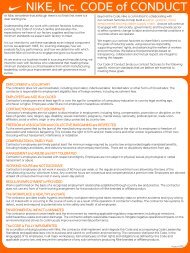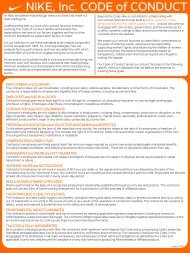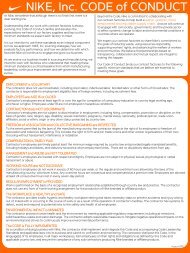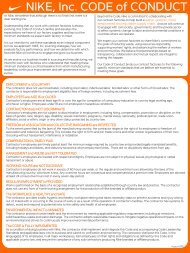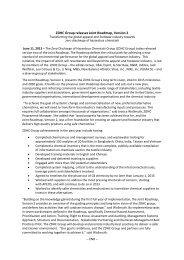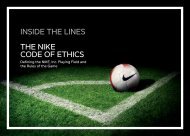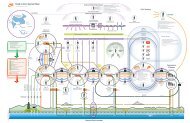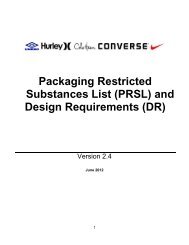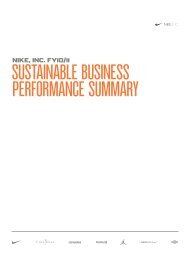COC CLS - Healthy Safety Environment - NIKE, Inc. - The Journey
COC CLS - Healthy Safety Environment - NIKE, Inc. - The Journey
COC CLS - Healthy Safety Environment - NIKE, Inc. - The Journey
Create successful ePaper yourself
Turn your PDF publications into a flip-book with our unique Google optimized e-Paper software.
WASTEWATER<br />
c. Identification of control measures to reduce the risk to the environment (e.g., training, inspection,<br />
water treatment).<br />
2. POLICIES & PROCEDURES—Each facility must implement procedures for the management of<br />
wastewater that include, as a minimum, the following:<br />
a. Evaluation and approval of all processes and equipment that will result in the discharge of<br />
wastewater prior to the installation or modification of equipment.<br />
b. An inventory of all pollution control equipment, including analytical test results that demonstrate<br />
compliance with all applicable regulations, standards and permit requirements. Inventories<br />
must be reviewed on an annual basis.<br />
c. Post local requirements/parameters in a centrally located within the WWTP.<br />
d. Water reuse and minimization efforts to reduce the quantity of wastewater.<br />
e. Obtain all required discharge permits.<br />
f. Contractor must conduct laboratory analyses of final wastewater effluent at the point of<br />
discharge to the environment using an approved analytical testing laboratory and methods to<br />
demonstrate compliance with applicable standards. At a minimum, sampling and testing must<br />
be conducted annually. Contractor must maintain documentation of the wastewater analyses<br />
for review by Nike, <strong>Inc</strong>. personnel upon request.<br />
g. Pollution control equipment must be suitable for the contaminants in the wastewater.<br />
h. Pollution control must not involve dilution by potable water, cooling water or storm water.<br />
Dilution is not an acceptable means of pollution control.<br />
i. Sampling must be conducted on a quarterly basis and include sampling locations, sampling<br />
methods and contaminants tested for.<br />
j. A process for reporting nonconformity, including corrective action.<br />
k. An inspection and maintenance schedule for pollution control equipment.<br />
l. A sampling and disposal program for any accumulated sludge. Industrial or process sludge<br />
cannot be used as compost, fertilizer fill material or any other land application without a<br />
regulatory permit specifically approving these uses.<br />
m. Effluent discharge point(s) must be a minimum of 100 meters from the nearest occupied<br />
structure or dwelling.<br />
3. TRAINING—all affected employees must receive wastewater awareness training on an annual basis.<br />
Training must include:<br />
<br />
<br />
Types of wastewater discharges, discharge points and sources.<br />
General knowledge of pollution control equipment.<br />
<strong>Environment</strong> <strong>CLS</strong> – Page 2 04.14.10



